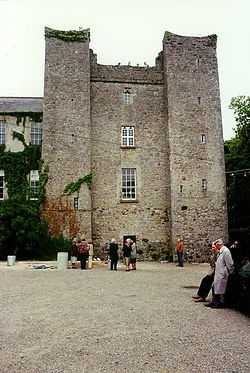Jenet Sarsfield
Jenet Sarsfield, Baroness Dunsany ( c.1528-1598 ) was an Anglo-Irish noblewoman, memorable for having six husbands.
Early life, first two marriages
She was born in Meath in the late 1520s, daughter of the merchant John Sarsfield. Her brother William was an alderman of Dublin.[1] Jenet's first husband was Robert Shilyngford, Lord Mayor of Dublin 1534-5.They had one daughter, Katherine, who was to be Jenet's only surviving child. After Robert's death, Jenet married James Luttrell, third son of Sir Thomas Luttrell; James was High Sheriff of County Dublin in 1556, and died in 1557. Jenet was pregnant at the time but the child died at or shortly after birth.
Lady Dunsany
After Luttrell's death, Jenet married as his second wife Robert Plunkett, 5th Baron of Dunsany. The marriage was short-lived and their two sons probably died in infancy.[2] Jenet in later years insisted on being described as the Dowager Lady Dunsany, despite three further marriages.
Lady Cusack
Dunsany died in 1559 and Jenet quickly remarried the former Lord Chancellor of Ireland, Sir Thomas Cusack.[3] Cusack, born about 1490, was probably old enough to be her grandfather. Though an immensely respected and upright public figure, his own marital career had been somewhat troubled. He had divorced his first wife Joan Hussey, and later refused to acknowledge that they had ever been married.[4] His second wife, Maud Darcy, was widely believed to have conspired with her second husband to murder her first. Maud's marriage to Cusack however was happy, and there is no evidence that Cusack and Jenet were unhappy, although she quarreled bitterly with her stepson Edward.
Widowhood
Cusack died in 1571. A widow was normally entitled to one-third of her husband's esate but Jenet, who was clearly a shrewd businesswoman, received a great deal more: Cusack left her most of his personal property, and the abbey of Lismullen, which he had acquired on the Dissolution of the Monasteries. These arrangements led to years of litigation between Jenet and Edward Cusack, to whom it has been said Jenet must have seemed the archetypal "wicked stepmother".[5] Jenet sued him for ransacking Lismullen and trying to destroy his father's will; he counterclaimed that she had unlawfully retained his mother's jewels. The litigation dragged on into the 1580s, when Edward appealed to Lord Burghley for aid. Interestingly he claimed that the parties were not evenly matched since Jenet through her numerous marriages was now connected with most of the great families of the Pale; no doubt he was thinking especially of her fifth husband Sir John Plunket, an influential judge and Privy Councillor. Jenet eventually vacated Lismullen, although Edward claimed that she had removed most of the valuables.
Lawsuits
Like many of the Anglo-Irish gentry she seems to have been litigious by nature, and her lawsuits were by no means confined to members of her own family. In 1572 one of the first cases heard by the Court of Castle Chamber, the Irish equivalent of Star Chamber, was brought by Jenet against Margaret Howth, widow, of Corballis, County Meath, and unnamed others, for riot and kidnapping.[6] Castle Chamber from the beginning was notorious for poor record-keeping and very few details of the case survive: it is known that Margaret Howth among others was found guilty as charged, and that a number of similar charges were made agaainst her by other plaintiffs.[7]
Lady Plunket
Her fifth husband was another distinguished elderly judge, Sir John Plunket, the Lord Chief Justice of Ireland. It was his third marriage and, though he was younger than Cusack, he must even so have been over seventy. The marriage seems to have been happy enough, although Plunket is known to have resented being dragged into Jenet's quarrel with her stepson. [8] He died in 1582 and in his will, although he lists an impressive inventory of valuables, he states that his marriage to Jenet left him none the richer.[9] They lived mainly as Dunsoghly Castle near Finglas, which survives today. In the adjoining chapel is a tablet displaying the initials of Plunket and Jenet, evidence perhaps of a happy marriage.[10]
Last marriage, death
 Dardistown Castle
Dardistown Castle
Jenet made a sixth marriage to John Bellew, who outlived her. In her last years she lived at Dardistown Castle, to which she made extensive additions. She died in 1598: she chose not to be buried with any of her husbands but in a tomb of her own, which still exists, at Moorchurch, near modern Julianstown in County Meath. She was buried under the title Lady Dunsany, a decision which confirms her reputation as a woman of exceptional independence and strength of character.
References
- ↑ Scott, Brendan "Career Wives or Wicked Stepmothers?" History Ireland (2009) Vol.17 Issue 1
- ↑ Burke's Peerage, 107th Edition Delaware 2003 Vol.1 p.1240
- ↑ Ball, F. Elrington The Judges in Ireland 1221-1921 John Murray London 1926 p.202
- ↑ Ball, p.202
- ↑ Scott "Career Wives or Wicked Stepmothers?"
- ↑ Crawford, Jon G. A Star Chamber Court in Ireland- the Court of Castle Chamber 1571-1641 Four Courts Press Dublin 2005 pp.148,201
- ↑ Crawford p.201
- ↑ Ball, F. Elrington History of Dublin Vol.6 1920 Alexander Thom and Co. Dublin, p.67
- ↑ Ball History of Dublin p.68
- ↑ Ball History of Dublin pp.68-9